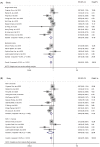Association between different proportions of crescents and adverse renal outcomes in immunoglobulin a nephropathy: a systematic review and meta-analysis
- PMID: 40398883
- PMCID: PMC12168408
- DOI: 10.1080/0886022X.2025.2495104
Association between different proportions of crescents and adverse renal outcomes in immunoglobulin a nephropathy: a systematic review and meta-analysis
Abstract
Objectives: Immunoglobulin A nephropathy (IgAN) had several pathological predictive factors, but the predictive value of crescents (C) for renal prognosis was controversial. We conducted a systematic review and meta-analysis to identify the association between crescents and renal outcomes of IgAN patients.
Methods: We searched PubMed, the Cochrane library and Ovid from database inception through to August 30, 2024. The analysis utilized risk ratio (RR) or mean difference (MD) along with the corresponding 95% confidence interval (CI). Data analysis was performed using Stata18 MP (Stata Corp) and RevMan 5.4. The proportion of crescents was classified as C0 (no crescents), C1 (crescents <25%), and C2 (crescents ≥25%).
Results: Eighteen studies were eligible, including 7,567 patients in the C0 group and 4,219 patients in the C group. Our meta-analyses revealed that compared to the C group, the C0 group had significantly lower incidence of composite kidney endpoint [RR = 0.56, 95% CI (0.45, 0.70)] and end-stage renal disease (ESRD) [RR = 0.64, 95% CI (0.51, 0.80)]. The C0 group had significantly higher estimated glomerular filtration rate (eGFR), lower proteinuria, and milder E1, S1, and T1/2 (all P values < 0.05). Compared to the C0 or C1 group, the C2 group was more likely to have composite kidney endpoint and ESRD. We did not find the benefit of immunosuppressant therapy (IST) in the C1, C2, or C group.
Conclusions: We found that IgAN patients with crescents had higher risk of composite kidney endpoints and ESRD, especially patients with C2 lesions. IST may not improve renal outcomes in IgAN patients with C1 or C2 lesions.
Keywords: Immunoglobulin A nephropathy; crescents; meta-analysis; renal outcomes; systematic review.
Conflict of interest statement
No potential conflict of interest was reported by the authors.
Figures






Similar articles
-
A validation study of crescents in predicting ESRD in patients with IgA nephropathy.J Transl Med. 2018 May 3;16(1):115. doi: 10.1186/s12967-018-1488-5. J Transl Med. 2018. PMID: 29724226 Free PMC article.
-
Renal Outcomes in Brazilian Patients with Immunoglobulin A Nephropathy and Cellular Crescentic Lesions.Kidney Blood Press Res. 2020;45(3):431-441. doi: 10.1159/000507251. Epub 2020 Apr 16. Kidney Blood Press Res. 2020. PMID: 32299081
-
Clinical implication of crescentic lesions in immunoglobulin A nephropathy.Nephrol Dial Transplant. 2014 Feb;29(2):356-64. doi: 10.1093/ndt/gft398. Epub 2013 Sep 29. Nephrol Dial Transplant. 2014. PMID: 24081867
-
Association between different proportions of crescents and the progression of IgA nephropathy (IgAN): a systematic review and meta-analysis.BMC Nephrol. 2024 Nov 5;25(1):396. doi: 10.1186/s12882-024-03839-w. BMC Nephrol. 2024. PMID: 39501179 Free PMC article.
-
Renal Outcomes of Pregnant Patients with Immunoglobulin A Nephropathy: A Systematic Review and Meta-Analysis.Am J Nephrol. 2019;49(3):214-224. doi: 10.1159/000496410. Epub 2019 Feb 26. Am J Nephrol. 2019. PMID: 30808834
References
Publication types
MeSH terms
LinkOut - more resources
Full Text Sources
Other Literature Sources
Medical
Research Materials
Miscellaneous
